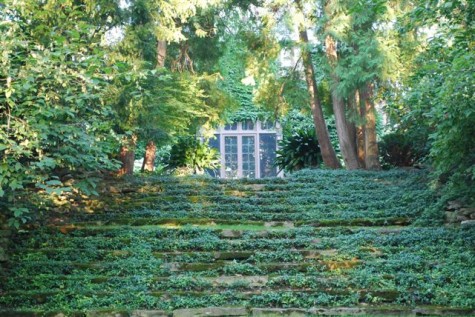 This very old, very lovely, wide flight of stairs was once buried in soil and debris; only the center four feet was still visible and useable. I discovered it by accident, while trying to plant trees and groundcover on either side. Once I explained to my client that another twelve feet of staircase still existed just below the surface, she had me uncover it entirely. We planted the risers with myrtle. This staircase is much more about ornament and architecture, than about going from one level to another. As the lower garden is viewed primarily from the house above, the beauty of these steps is more important than the issue of how to get from here to there.
This very old, very lovely, wide flight of stairs was once buried in soil and debris; only the center four feet was still visible and useable. I discovered it by accident, while trying to plant trees and groundcover on either side. Once I explained to my client that another twelve feet of staircase still existed just below the surface, she had me uncover it entirely. We planted the risers with myrtle. This staircase is much more about ornament and architecture, than about going from one level to another. As the lower garden is viewed primarily from the house above, the beauty of these steps is more important than the issue of how to get from here to there.
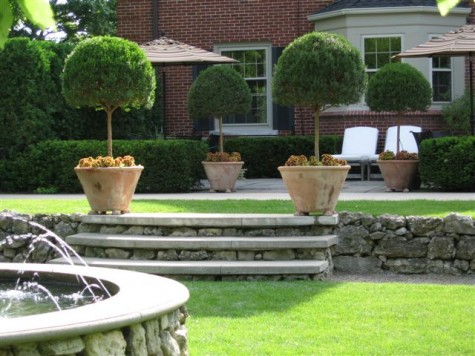 The change of level in a landscape can create interest, announce a new garden room-change things up. This previously sloped garden space was excavated and walled with the stone that had been used to edge the original beds. The steps now necessary to descend to the lower level signal the transition. The treads are shallow, so as not to intrude on the rectangle of grass below. A good height for a step is 7 inches; 8 inches will work, but is just slightly on the steep side. Every step in a flight of stairs needs to be the same height; people instinctively assume this. Note how the gravel in front of the wall, dying into the lower step, makes the maintenance of the lawn plane simple.
The change of level in a landscape can create interest, announce a new garden room-change things up. This previously sloped garden space was excavated and walled with the stone that had been used to edge the original beds. The steps now necessary to descend to the lower level signal the transition. The treads are shallow, so as not to intrude on the rectangle of grass below. A good height for a step is 7 inches; 8 inches will work, but is just slightly on the steep side. Every step in a flight of stairs needs to be the same height; people instinctively assume this. Note how the gravel in front of the wall, dying into the lower step, makes the maintenance of the lawn plane simple.
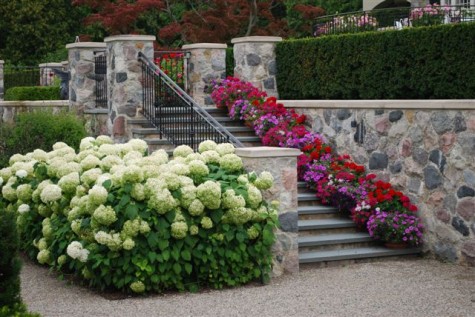 Some changes of level are dramatic, and require a flight of steps, and railings. Any stairs need to be designed first and foremost to allow for safe passage. Each of these steps is marked with its own pot of flowers. The iron railing is as sturdy as it is beautiful. Iron rails allow a garden to remain open to view while providing some security.
Some changes of level are dramatic, and require a flight of steps, and railings. Any stairs need to be designed first and foremost to allow for safe passage. Each of these steps is marked with its own pot of flowers. The iron railing is as sturdy as it is beautiful. Iron rails allow a garden to remain open to view while providing some security.
 Splitting up steps can be even more friendly to guests. It is far easier to negotiate one or two steps at a time, with a landing in place prior to the next set of steps. These stairs are wider that the door and side windows; this makes for a generous and welcoming approach.
Splitting up steps can be even more friendly to guests. It is far easier to negotiate one or two steps at a time, with a landing in place prior to the next set of steps. These stairs are wider that the door and side windows; this makes for a generous and welcoming approach.
 This winding staircase seems to spill out of the confluence of two walls designed and built on the bias. The variation in stair width creates a sense of motion and rhythm which is very pleasing. The wall enclosure makes it possible to climb these stairs with confidence.
This winding staircase seems to spill out of the confluence of two walls designed and built on the bias. The variation in stair width creates a sense of motion and rhythm which is very pleasing. The wall enclosure makes it possible to climb these stairs with confidence.
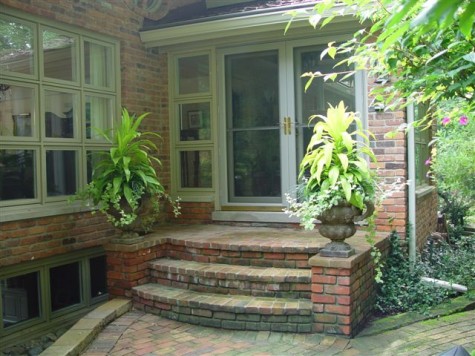 Stairs can vary in their depth. The first stair out of this front door functions as a landing-a comfortable space for greetings, and goodbys. The brick piers and pots are a succesful alternative to railings, which would have seemed so heavy handed here.
Stairs can vary in their depth. The first stair out of this front door functions as a landing-a comfortable space for greetings, and goodbys. The brick piers and pots are a succesful alternative to railings, which would have seemed so heavy handed here.
 Natural stone frequently has a uneven surface. Planning for a safe ascent and descent is doubly important. The iron fence walls inset from the stairs provide an emergency handhold for anyone loosing their footing.
Natural stone frequently has a uneven surface. Planning for a safe ascent and descent is doubly important. The iron fence walls inset from the stairs provide an emergency handhold for anyone loosing their footing.
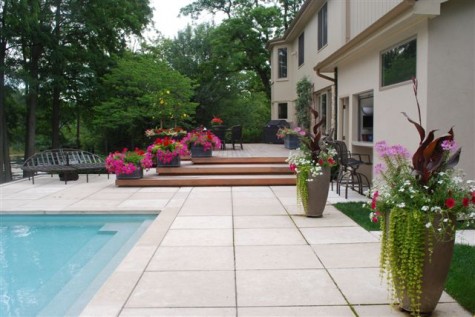 These wood stairs to the upper terrace are very spacious in every dimension. Steps with greater depth are easier to negotiate. Steps to a rear terrace are frequently used while carrying food and drink; it is better to err on the side of too deep, than too shallow. The pots announce the change of level for anyone concentrating more on keeping their tray of food where it belongs, , than watching where they step.
These wood stairs to the upper terrace are very spacious in every dimension. Steps with greater depth are easier to negotiate. Steps to a rear terrace are frequently used while carrying food and drink; it is better to err on the side of too deep, than too shallow. The pots announce the change of level for anyone concentrating more on keeping their tray of food where it belongs, , than watching where they step.

Thinking through what you need from your steps is just as important a part of the design as how they look. Will guests take them in stride? Will they be easy to rid of snow? After those questions are answered, then figure out how all your concerns can be all wrapped up in a good looking package.